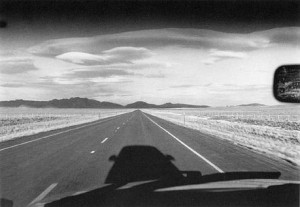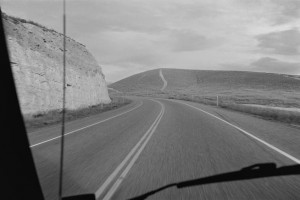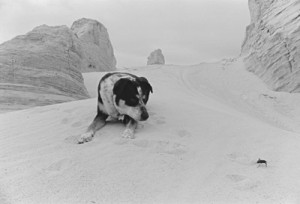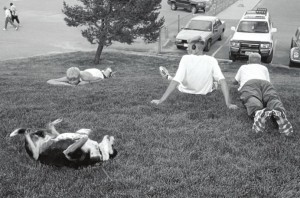Seeing in Passing: Photographs by Chuck Forsman, the current photography exhibit at the Denver Art Museum, once again demonstrates Curator of Photography Eric Paddock’s willingness to show lesser known photographers, so long as their work manifests the essence of the art: elements of formal beauty coupled with a narrative that relates to some universal human emotion or concern. Forsman, an artist better known for his landscape paintings, clearly has the right stuff.

The exhibit is fairly large (over 50 prints), and is presented in two distinct, but related, sets of work—Western Rider, photographs taken through the car window while Forsman drives the highways and byways of the West, and Walking Magpie, photographs taken while Forsman walks his dog Magpie around Boulder and in the hills and dales of the West. The linkage between the two sets of work is precisely Forsman talent in capturing something special in otherwise common fleeting scenes to which most of us would not give a second thought. This is not an exhibition of a deeply conceptual body of work. However, by freezing these uncomplicated, commonplace scenes, Forsman asks us to reconsider what we are missing as we rush through life, most often completely unaware of the special little moments occurring all around us.

Most of the Western Rider images are bordered by the frame of the car; often the rear view or side view mirrors intrude into the picture plane. This creates a setting that we are all familiar with. We understand the context. Ever been on the open road, with no one else around, seemingly forever? Recall that feeling? That is Home Stretch in a nutshell. Ever spotted a side road off to somewhere unknown, and wondered where it goes, what would happen if you … ? That is the feeling evoked by Double Take. And so it goes with most of the thirty-odd Western Rider images.
From a formal perspective, Forsman often uses the car body or other elements of the car as framing elements, or as counterweights, or to establish the familiar context of the car cockpit. In Home Stretch, a portion of the rearview mirror intrudes in the upper right quadrant of the image and breaks up the otherwise dulling symmetry of the scene. In Double Take, the car’s frame and a windshield wiper form a visual notch to focus our eyes on the driver’s decision ahead: continue on the main road to the planned destination, or take the side road to unknown adventure. The fact that Forsman understands composition so well can be attributed to his painter’s background. The fact that he is able to compose the photographs so well despite the dynamic context in which they are captured (many of the photographs clearly are taken while Forsman is barreling down the highway) speaks to skills usually attributed to war, street, or sports photographers.
Not all of the Western Rider images are special— not surprising for an exhibit with so many images. Caffeine Medley, a subset of Rider, consists of nine similar images arranged on a small exhibit wall. Each photograph was taken at night, while Forsman apparently is moving at highway speeds. The result is that each photograph is a variation on the theme of stretched and wiggly lines and lights. Caffeine Medley does evoke the sense of the classic, coffee-powered ‘all-nighter on the open road’, but the repetition of similar imagery was overkill. One or two of the better images would have made the point. Moreover, some of the Medley photographs are sloppily matted, and the mounting of so many photographs in a tight space resulted in poor lighting on some of them. Overall though, the Western Rider images evoke a sense of shared experience, a feeling of “You know, I’ve seen something like that”; and “I’ve felt that way on long road trips too.” Riding shotgun on Western Rider is an enjoyable journey.

The real treat of this exhibit, however, are the twenty or so Walking Magpie images. I was thoroughly charmed by the images of Magpie, wandering around her world, a study—to paraphrase Paddock’s wall text—in the acceptance of her world as it is, and the insatiable desire to explore it. Do you remember the first time you came upon a really big bug? If you don’t, then spend a little time with Near Tooele, Utah. Don’t recall the fun of rolling around on a grassy slope? Near Denver, Colorado will cure that. At the risk of overstating this, Magpie represents the lost freedom of childhood.

Again, Seeing in Passing is not an exhibit where you have to strain to dig out the deep, conceptual meaning of the work. Instead, it readily offers its meaning in its easily recognizable, gentle reminders of little moments of our lives that sometimes pass us by without notice. Those reminders make Seeing in Passing worth seeing.
Seeing in Passing: Photographs by Chuck Forsman is on exhibit at the Denver Art Museum through May 25, 2014.